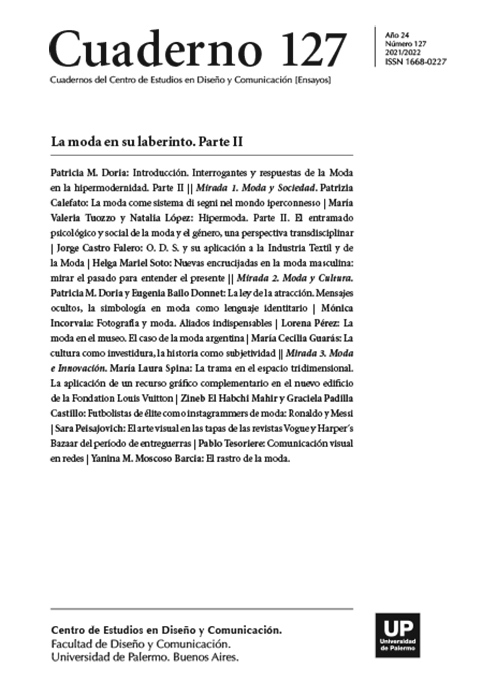El rastro de la moda
Abstract
A route is proposed that begins with obtaining raw materials, but does not end in the finished product, but rather diversifies into many other linked routes, each one aimed at distributing, showing, promoting, advertising; that is to say, to allow the arrival to each one of the possible consumers, offering them much more than the product itself. Since its origins, fashion proposes and produces behaviors and changes in societies. In many cases, these changes have been maintained permanently, although the fashion that prompted them disappeared.
In any case, it can be said that fashion, as an ephemeral social phenomenon, does not completely disappear, but rather produces a permanent mark; a trail that can be traversed, a trail that functions as a witness and allows to identify patterns, to evaluate and propose actions in order to minimize and decelerate the impact of large-scale production of fashion items, create new habits and sustain them in the weather.
References
Benveniste, A. (2020). Esta herramienta te dice cuánto dañan el medio ambiente tus hábitos de moda. (CNN Busisnes). Recuperado el 08/07/2020 de https://cnnespanol.cnn.com/2020/01/15/esta-herramienta-te-dice-cuanto-danan-elmedio-ambiente-tus-hábitos-de-moda/?fbclid=IwAR02fUWkgSHEjEBCGAVOmbEBvb7d8HI6pjEQZ9loQyelSW4uvlMoP2FBI
Croci, P. y Vitale, A. (2000). Los cuerpos dóciles. Hacia un tratado sobre la moda. Buenos Aires: Editorial La Marca editora.
¿Cuánto le cuestan nuestros armarios al medio ambiente? (2019). Banco Mundial (2019) Recuperado el 06/06/2020 de https://www.bancomundial.org/es/news/feature/2019/09/23/costo-moda-medioambiente
Flügel, J. C. (1964). Psicología del vestido. Buenos Aires: Editorial Paidós.
Montojo, M. (20 septiembre, 2019). La ruina textil: 800.000 toneladas de ropa van a la basura cada año. (El Ágora) Recuperado el 06/06/2020 de https://www.elagoradiario.com/desarrollo-sostenible/economia-circular/la-ruinatextil-800-000-toneladas-de-ropa-van-a-la-basura-cada-ano/ Real Academia Española. (2020). Diccionario de la lengua española, 23.ª ed. Disponible en: https://dle.rae.es.
Squicciarino, N. (1990). El vestido habla: Consideraciones psico-sociológicas sobre la indumentaria. Madrid: Ediciones Cátedra, S. A.
Barthes, R. (1978). El sistema de la moda. Barcelona: Gustavo Gilli. La moda busca bajar su huella en el ambiente. (2018). Recuperado el 08/07/2020 de https://www.elcomercio.com/tendencias/moda-bajar-huella-ambiente-planeta.html
Lomazzi, G. (1972). Un consumo ideológico. Psicología del vestir. Barcelona: Lumen. Citado en: Croci P. y Vitale A. (2000). Los cuerpos dóciles. Hacia un tratado sobre la moda. Buenos Aires: La Marca
Los autores/as que publiquen en esta revista ceden los derechos de autor y de publicación a "Cuadernos del Centro de Estudios de Diseño y Comunicación", Aceptando el registro de su trabajo bajo una licencia de atribución de Creative Commons, que permite a terceros utilizar lo publicado siempre que de el crédito pertinente a los autores y a esta revista.


